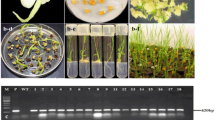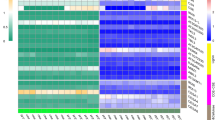Abstract
cDNA and genomic clones of cinnamoyl CoA reductase measuring 1011 and 2992 bp were isolated from a leguminous pulpwood tree Leucaena leucocephala, named as LlCCR. The cDNA exhibited 80–85% homology both at the nucleotide and amino acid levels with other known sequences. The genomic sequence contained five exons and four introns. Sense and antisense constructs of LlCCR were introduced in tobacco plants to up and down-regulate this key enzyme of lignification. The primary transformants showed a good correlation between CCR transcript levels and its activity. Most of the CCR down-regulated lines displayed stunted growth and development, wrinkled leaves and delayed senescence. These lines accumulated unusual phenolics like ferulic and sinapic acids in cell wall. Histochemical staining suggested reduction in aldehyde units and increased syringyl over guaiacyl (S/G) ratio of lignin. Anatomical studies showed thin walled, elongated xylem fibres, collapsed vessels with drastic reduction of secondary xylem. The transmission electron microscopic studies revealed modification of ultrastructure and topochemical distribution of wall polysaccharides and lignin in the xylem fibres. CCR down-regulated lines showed increased thickness of secondary wall layers and poor lignification of S2 and S3 wall layers. The severely down-regulated line AS17 exhibited 24.7% reduction of Klason lignin with an increase of 15% holocellulose content. Contrarily, the CCR up-regulated lines exhibited robust growth, development and significant increase in lignin content. The altered lignin profiles observed in transgenic tobacco lines support a role for CCR down-regulation in improving wood properties of L. leucocephala exclusively used in the pulp and paper industry of India.








Similar content being viewed by others
References
Adler E, Björkquist J, Häggroth S (1948) Über die Ursache der Farbreaktionen des Holzes. Acta Chem Scand 2:93–94
Altschul SF, Gish W, Miller W, Myers EW, Lipman DJ (1990) Basic local alignment search tool. J Mol Biol 215:403–410
Atanassova R, Favet N, Martz F, Chabbert B, Tollier MT, Monties B, Fritig B, Legrand M (1995) Altered lignin composition in transgenic tobacco expressing O-methyltransferase sequences in sense and antisense orientation. Plant J 8:465–477
Baucher M, Halpin C, Petit-Conil M, Boerjan W (2003) Lignin: genetic engineering and impact on pulping. Crit Rev Biochem Mol 38:305–350
Berlyn GP, Miksche JP (1976) Botanical microtechnique and cytochemistry. Iowa State University Press, Ames
Boudet AM, Kajita S, Grima-Pettenati J, Goffner D (2003) Lignins and lignocellulosics: a better control of synthesis for new and improved uses. Trends Plant Sci 8:576–581
Bradford MM (1976) A rapid and sensitive method for the quantitation of microgram quantities of protein utilizing the principle of protein–dye binding. Anal Biochem 72:248–254
Chabannes M, Ruel K, Yoshinaga A, Chabbert B, Jauneau A, Joseleau JP, Boudet AM (2001a) In situ analysis of lignins in transgenic tobacco reveals a differential impact of individual transformations on the spatial patterns of lignin deposition at the cellular and subcellular levels. Plant J 28:271–282
Chabannes M, Barakate A, Lapierre C, Marita JM, Ralph J, Pean M, Danoun S, Halpin C, Grima-Pettenati J, Boudet AM (2001b) Strong decrease in lignin content without significant alteration of plant development is induced by simultaneous down-regulation of cinnamoyl CoA reductase (CCR) and cinnamyl alcohol dehydrogenase (CAD) in tobacco plants. Plant J 28:257–270
Chiang VL, Puumala RJ, Takeuchi H, Eckert RE (1988) Comparison of softwood and hardwood kraft pulping. Tappi J 71:173–176
Dence CW (1992) Lignin determination. In: Lin SY, Dence CW (eds) Methods in lignin chemistry, Springer Series in Wood Science. Springer, Berlin, pp 33–61
Dixon RA, Lamb CJ, Masoud S, Sewalt VJH, Paiva NL (1996) Metabolic engineering: prospects for crop improvement through the genetic manipulation of phenylpropanoid biosynthesis and defense responses—a review. Gene 179:61–71
Donaldson L (1992) Lignin distribution during late wood formation in Pinus radiata D.DON. IAWA Bull 13:381–387
Doyle JJ, Doyle JL (1990) A rapid total DNA preparation procedure for fresh plant tissue. Focus 12:13–15
Funnell D, Pedersen J (2006) Reaction of sorghum lines genetically modified for reduced lignin content to infection by Fusarium and Alternaria spp. Plant Dis 90:331–338
Franke R, Humphreys JM, Hemm MR, Denault JW, Ruegger MO, Cusumano JC, Chapple C (2002) The Arabidopsis REF8 gene encodes the 3-hydroxylase of phenylpropanoid metabolism. Plant J 30:33–45
Frohman MA, Dush MK, Martin GR (1988) Rapid production of full-length cDNAs from rare transcripts: amplification using a single gene-specific oligonucleotide primer. Proc Natl Acad Sci USA 85:8998–9002
Goujon T, Ferret V, Mila I, Pollet B, Ruel K, Burlat V, Joseleau JP, Barrie`re Y, Lapierre C, Jouanin L (2003) Down-regulation of the AtCCR1 gene in Arabidopsis thaliana: effects on phenotype, lignins and cell wall degradability. Planta 217:218–228
Hahlbrock K, Grisebach H (1979) Enzymic controls in the biosynthesis of lignin and flavonoids. Annu Rev Plant Physiol 30:105–130
Holsters M, De Waele D, Depicker A, Messens E, Van Montague Schell J (1978) Transfection and transformation of Agrobacterium tumefaciens. Mol Genet 163:181
Horsch RB, Fry JE, Hoffman NL, Eichholtz D, Rogers SG, Fraley RT (1985) A simple and general method for transferring genes into plants. Science 227:1229–1231
Hu WJ, Harding SA, Lung J, Popko JL, Ralph J, Stokke DD, Tsai CJ, Chiang VL (1999) Repression of lignin biosynthesis promotes cellulose accumulation and growth in transgenic trees. Nat Biotechnol 17:808–812
Iiyama K, Pant R (1988) The mechanism of the Maule colour reaction introduction of methylated syringyl nuclei into softwood lignin. Wood Sci Technol 22:167–175
Jones L, Ennos AR, Turner SR (2001) Cloning and characterization of irregular xylem4 (irx4): a severely lignin-deficient mutant of Arabidopsis. Plant J 26:205–216
Kitin P, Voelker SL, Meinzer FC, Beeckman H, Strauss SH, Lachenbruch B (2010) Tyloses and phenolic deposits in xylem vessels impede water transport in low-lignin transgenic populus: a study by cryo-fluorescence microscopy. Plant Physiol 154:887–898
Lacombe E, Hawkins S, Van Doorsselaere J, Piquemal J, Goffner D, Poeydomenge O, Boudet AM, Grima-Pettenati J (1997) Cinnamoyl CoA reductase, the first committed enzyme of the lignin branch biosynthetic pathway: cloning, expression and phylogenetic relationships. Plant J 11:429–441
Laskar DD, Jourdes M, Patten AM, Helms GL, Davin LB, Lewis NG (2006) The Arabidopsis cinnamoyl CoA reductase irx4 mutant has a delayed but coherent (normal) program of lignification. Plant J 48:674–686
Lee TT, Skoog F (1965) Effects of substituted phenols on bud formation and growth of tobacco tissue cultures. Physiol Plant 18:386–402
Leple JC, Dauwe R, Morreel K, Storme V, Lapierre C, Pollet B, Naumann A, Kang KY, Kim H, Ruel K, Lefèbvre A, Joseleau JP, Grima-Pettenati J, De Rycke R, Andersson-Gunnerås S, Erban A, Fehrle I, Petit-Conil M, Kopka J, Polle A, Messens E, Sundberg B, Mansfield SD, Ralph J, Pilate G, Boerjan W (2007) Downregulation of cinnamoyl-coenzyme A reductase in poplar: multiple-level phenotyping reveals effects on cell wall polymer metabolism and structure. Plant Cell 19:3669–3691
Luderitz T, Grisebach H (1981) Enzymic synthesis of lignin precursors. Comparison of cinnamoyl-CoA reductase and cinnamyl alcohol: NADP + dehydrogenase from spruce (Picea abies L.) and soybean (Glycine max L). Eur J Biochem 119:115–124
Maher EA, Bate NJ, Ni W, Elkind Y, Dixon RA, Lamb CJ (1994) Increased disease susceptibility of transgenic tobacco plants with suppressed levels of preformed phenylpropanoid products. Proc Natl Acad Sci USA 91:7802–7806
Meyermans H, Morreel K, Lapierre C, Pollet B, De Bruyn A, Busson R, Herdewijn P, Devreese B, Van Beeumen J, Marita JM, Ralph J, Chen C, Burggraeve B, Van Montagu M, Messens E, Boerjan W (2000) Modification in lignin and accumulation of phenolic glucosides in poplar xylem upon down-regulation of caffeoyl-coenzyme A O-methyltransferase, an enzyme involved in lignin biosynthesis. J Biol Chem 275:36899–36909
Mir Derikvand M, Sierra JB, Ruel K, Pollet B, Do CT, Thevenin J, Buffard D, Jouanin L, Lapierre C (2008) Redirection of the phenylpropanoid pathway to feruloyl malate in Arabidopsis mutants deficient for cinnamoyl-CoA reductase 1. Planta 227:943–956
Nitsch JP, Nitsch C (1962) Compose’ phenoliques et croissance vegetale. Ann Physiol Veg 4:211–225
O’Malley DM, Porter S, Sederoff RR (1992) Purification, characterization and cloning of cinnamyl alcohol dehydrogenase in loblolly pine (Pinus taeda L.). Plant Physiol 98:1364–1371
O’Connell A, Holt K, Piquemal J, Grima-Pettenati J, Boudet A, Pollet B, Lapierre C, Petit-Conil M, Schuch W, Halpin C (2002) Improved paper pulp from plants with suppresses cinnamoyl-CoA reductase or cinnamyl alcohol dehydrogenase. Transgenic Res 11:495–503
Pedersen JF, Vogel KP, Funnell DL (2005) Impact of reduced lignin on plant fitness. Crop Sci 45:812–819
Peter GF, White DE, De La Torre R, Singh R, Newman D (2007) The value of forest biotechnology: a cost modelling study with loblolly pine and kraft linerboard in the south eastern USA. Int J Biotechnol 9:415–435
Pincon G, Chabannes M, Lapierre C, Pollet B, Ruel K, Joseleau JP, Boudet AM, Legrand M (2001) Simultaneous down regulation of caffeic/5-hydroxy ferulic acid-O-methyl transferase I and cinnamoyl-Coenzyme A reductase I the progeny from across between tobacco line homozygous for each transgene. Consequence for plant development and lignin synthesis. Plant Physiol 126:145–155
Piquemal J, Lapierre C, Myton K, O’Connell A, Schuch W, Grima-Pettenati J, Boudet AM (1998) Down-regulation of cinnamoyl-CoA reductase induces significant changes of lignin profiles in transgenic tobacco plants. Plant J 13:71–83
Ralph J, Hatfield RD, Piquemal J, Yahiaoui N, Pean M, Lapierre C, Boudet AM (1998) NMR characterization of altered lignins extracted from tobacco plants down-regulated for lignification enzymes cinnamyl-alcohol dehydrogenase and cinnamoyl-CoA reductase. Proc Natl Acad Sci USA 95:12803–12808
Ralph J, Kim H, Lu F, Grabber JH, Leple JC, Berrio-Sierra J, Derikvand MM, Jouanin L, Boerjan W, Lapierre C (2008) Identification of the structure and origin of a thioacidolysis marker compound for ferulic acid incorporation into angiosperm lignins (and an indicator for cinnamoyl CoA reductase deficiency). Plant J 53:368–379
Ruegger M, Dewey E, Hobbie L, Brown D, Bernasconi P, Turner J, Muday G, Estelle M (1997) Reduced naphthylphthalamic acid binding in the tir3 mutant of Arabidopsis is associated with a reduction in polar auxin transport and diverse morphological defects. Plant Cell 9:745–757
Sambrook J, Russell DW (2001) Molecular cloning: a laboratory manual, 3rd edn. Cold Spring Harbor Laboratory Press, USA
Shirley B (1996) Flavonoid biosynthesis: “new” functions for an “old” pathway. Trends Plant Sci 1:377–382
Singh AP, Daniel G (2001) The S2 layer in the tracheid walls of Picea abies wood: inhomogeneity in lignin distribution and cell wall microstructure. Holzforschung 55:373–378
Speer EO (1987) A method of retaining phloroglucinol proof lignin. Stain Technol 62:279–280
Spurr AR (1969) A low viscosity resin embedding medium for electron microscopy. J Ultrastruc Res 26:31–43
Tamasloukht B, Won Quai Lam MSJ, Martinez Y, Tozo K, Barbier O, Jourda C, Jauneau A, Borderies G, Balzergue, Ronou JP, Huguet S, Martinant JP, Tatout C, Lapierre C, Barriere Y, Gofner D, Pichon M (2011) Characterization of a cinnamoyl-CoA reductase 1 (CCR1) mutant in maize: effects on lignification, fibre development, and global gene expression. J Exp Bot doi:10.1093/jxb/err077
Teutonico RA, Dudley MW, Orr JD, Lynn DG, Binns AN (1991) Activity and accumulation of cell division–promoting phenolics in tobacco tissue cultures. Plant Physiol 97:288–297
Thiery JP (1967) Mise en evidence des polysaccharides sur coupes fines en microscopie electronique. J Microscopie 6:927–1017
Thompson JD, Gibson TJ, Plewniak F, Jeanmougin F, Higgins DG (1997) The ClustalX windows interface: flexible strategies for multiple sequence alignment aided by quality analysis tools. Nucl Acids Res 24:4876–4882
Van der Krol AR, Lenting PE, Veenstra J, Van der Meer IM, Koes RE, Gerats AGM, Mol JNM, Stuitje AR (1988) An antisense chalcone synthase gene in transgenic plants inhibits flower pigmentation. Nature 333:866–869
Van Doorsselaere J, Baucher M, Chognot E, Chabbert B, Tollier MT, Petit-Conil M, Leple JC, Pilate G, Cornu D, Monties B, Van Montagu M, Inze D, Boerjan W, Jouanin L (1995) A novel lignin in poplar trees with a reduced caeffic acid/5-hydroxyferulic acid)-methyltransferase activity. Plant J 8:855–864
Vanholme R, Morreel K, Ralph J, Boerjan W (2008) Lignin engineering. Curr Opin Plant Biol 11:278–285
Voelker SL, Lachenbruch B, Meinzer FC, Jourdes M, Ki C, Patten AM, Davin LB, Lewis NG, Tuskan GA, Gunter L, Decker SR, Seelig MJ, Sykes R, Himmel ME (2010) Antisense down-regulation of 4CL alters lignification, tree growth and saccharification potential of field-grown poplar. Plant Physiol 154:874–876
Voelker SL, Lachenbruch B, Meinzer FC, Kitin P, Strauss SH (2011) Transgenic poplars with reduced lignin showed impaired xylem conductivity, growth efficiency and survival. Plant Cell Environ 34:655–668
Zenk MH, Muller G (1963) In vivo destruction of exogenously applied indolyl-3-acetic acid as influenced by naturally occurring phenolic acids. Nature 200:761–763
Zhong R, Taylor JJ, Ye ZH (1997) Disruption of interfascicular fiber differentiation in an Arabidopsis mutant. Plant Cell 9:2159–2170
Acknowledgments
This work was supported by a grant from the Council of Scientific and Industrial Research (CSIR-NMITLI), New Delhi, India and we gratefully acknowledge the financial assistance. We are also thankful to the University Grants Commission, New Delhi for financial assistance in the form of funds for Centre for Advanced Studies to the Department of Genetics, Osmania University.
Author information
Authors and Affiliations
Corresponding author
Additional information
Communicated by P. Kumar.
Electronic supplementary material
Below is the link to the electronic supplementary material.
Fig. S1. Southern blot analysis of CCR sense and antisense transgenic tobacco plants showing gene integration using CCR gene specific probe. The DNA of sense, antisense transgenic plants and controls were digested with HindIII. Positive hybridization was observed at the 1011 bp region for each putative sense (A) and antisense (B) CCR transgenic plant samples except in controls. A - Lane1: Positive control; Lane2: Negative control; Lane3: S2; Lane4: S5; Lane11: S6; Lane12: S27 and Lane13: S9. B - Lane1: Positive control; Lane2: Negative control; Lane3: AS2; Lane4: AS3; Lane5: AS4; Lane5: AS12; Lane6: AS17
Fig. S2. RT-PCR analysis of CCR sense and antisense transgenic tobacco plants with CCR gene specific primers. Lane1: 1 kb ladder; Lane2: AS2; Lane3: AS3; Lane4: AS17; Lane5: AS4; Lane6: AS12; Lane7: Control; Lane8: S2; Lane9: S5; Lane10: S6; Lane11: S27; Lane12: S9. CCR antisense transgenic lines showed faint amplification as compared to sense CCR transgenics indicating up and down-regulation of CCR gene
Fig. S3 Phenotype of CCR sense and antisense transgenic lines. S5: CCR sense transgenic line; AS17: severely down-regulated CCR antisense transgenic line. C: Control
Fig. S4 Electron micrographs of stems of control and CCR sense and antisense transgenic tobacco lines. A and B Periodic acid–thiocarbohydrazide–silver proteinate (PATAg) staining. Control (A) showed less periodate reaction in the S1 and S3 layers. S2 layer showed relatively more carbohydrates. The secondary wall layers S1 and S2 in the antisense plants (B) showed intense staining indicating increased concentration of carbohydrates. C – E staining with KMnO4. Electron micrographs of fibre walls stained with KMnO4 showing lignin distribution pattern in control (C) and CCR antisense (D) and sense (E) plants. In control high lignin distribution was observed in CML, S1 and S3 layers of secondary wall. Antisense line showed lignin distribution limited to the middle lamellae and S1 layer. Sense line showed high lignin distribution in the S3 layer of secondary wall. CML: Cell corner middle lamellae; S1, S2, S3: Secondary cell wall layers. Scale bar = 0.5 micron
Rights and permissions
About this article
Cite this article
Prashant, S., Srilakshmi Sunita, M., Pramod, S. et al. Down-regulation of Leucaena leucocephala cinnamoyl CoA reductase (LlCCR) gene induces significant changes in phenotype, soluble phenolic pools and lignin in transgenic tobacco. Plant Cell Rep 30, 2215–2231 (2011). https://doi.org/10.1007/s00299-011-1127-6
Received:
Revised:
Accepted:
Published:
Issue Date:
DOI: https://doi.org/10.1007/s00299-011-1127-6




